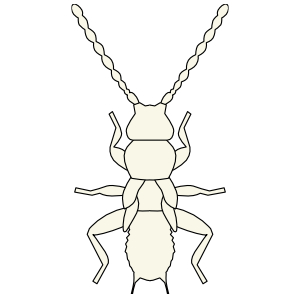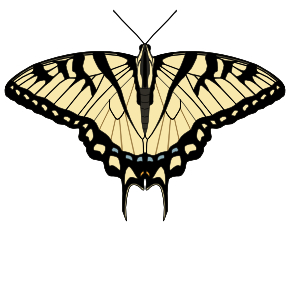Hexapodium

Segmented bodies, usually with paired, segmented appendages. Exoskeleton. Little to no metamorphosis. Most young resemble the adults; variation in the number of legs between immatures and adults exist among the millipedes and some centipedes and arachnids. Immature crustaceans bear little resemblance to the adults.
Greek: arthro = joint; pod = foot or leg.
There are about a million named species of arthropods on Earth, with an estimated 5 to 10 million species.

Head, thorax, and abdomen. Three pairs of legs. Chitinous exoskeleton.
Greek: hex = six; podos = foot or leg; in reference to the six legs possessed by Hexapods.

No wings. Chewing mouthparts retracted inside the head. Simple eyes or none at all. 6-segmented abdomens. Probably not monophyletic; interrelationships are still being sorted. Similarities may be due to similar habitat (soil or similar substrates) or miniature sizes.
Greek: ento = inner, gnathos = jaw; in reference to their retracted mouthparts.

Small, most species 1 to 3 mm in length; exceptions: Tetrodontophora bielanensis, 9 mm; and Holacanthella duospinosa, 17 mm. Body elongate or globular. Eyes primitive compound or absent. Antennae 4-segmented. Abdomen 6-segmented. Ventral side of abdomen bears the Collophore (also known ast the ventral tube; segment I); the retinaculum (segment III); and the furculum (segment IV). Genitalia internal.
Greek: kolla = glue, embolon = peg (in reference to the collophore).

No eyes, wings, or antennae. Usually whitish or pale brown. First pair of legs function as antennae. Body elongate and cylindrical. Post-anal telson. No cerci. Styli on first 3 abdominal segments. Most families exchange gas by diffusion; 2 families (Eosentomidae and Sinentomidae) have a simple tracheal system with spiracles on the mesothorax and metathorax.
Greek: protos = first, oura = tail; first as in primitive, tail in reference to the lack of cerci...though it seems to me, a more accurate name might have been "first-no-tail": Protanuran (pro = first, an = no, ura = tail).

No eyes, wings, or antennae. Usually whitish or pale brown. First pair of legs function as antennae. Body elongate and cylindrical. Post-anal telson. No cerci. Styli on first 3 abdominal segments. Most families exchange gas by diffusion; 2 families (Eosentomidae and Sinentomidae) have a simple tracheal system with spiracles on the mesothorax and metathorax.
Greek: diplos = double, oura = tail; in reference to the pair of characteristic caudal appendages or filaments at the posterior end of the body.

Head, thorax, abdomen. Two antennae, three pairs of legs attached to the thorax.
Latin: insectum = cut up (because they appear to be cut into three parts).

Compound eyes, external mouthparts. Some with scales covering body. Primitive, wingless insects. 0.2 - 0.8 inches in length (5 to 20 mm). Three slender bristle-like appendages at the end of the abdomen. Long-lived, 2 to 3 years to reach sexual maturity; may live up to 7 years. Molts 3 to 5 times a year.
Historically placed in the order Thysanura.
Greek: archaeos = ancient, gnatha = jaw.

Dorsiventrally flattened bodies. Elongated or oval in outline. Slender antennae. Small compound eyes; some lack eyes (families Nicoletiidae and Protrinemuridae and those species that live in habitats sheltered from sunlight - troglobites).
Historically placed in the order Thysanura.
Greek: zyg = bridge, entoma = insect.

Greek: pterygo = wing.

Wing held upright or outstretched at rest.
Greek: palaiós = old; pteron = wing.

Vestigial mouthparts. Hindwings smaller than forewings or absent. Wings held over body when at rest. Long front legs. Males have large compound eyes. Three long terminal appendages. Characteristics curved outline.
Greek: ephemeros = short-lived or ephemeral, pteron = wing; in reference to the short lifespan of the adults.

Large head. Long, slender abdomen. Short antennae with bristle-like flagellum. Indirect flight system. Legs form a basket for catching prey while in flight. Secondary copulatory organ at the abdominal base of the male.
Two suborders: Zygoptera (damselflies) and Anispotera (dragonflies).
Greek: odontos = tooth; in reference to the mandibular teeth.

Able to fold wings back over their abdomens.
Greek: néos = new, pterón = wing.

Forewings (tegmina) are leathery or thick. Hind wings are expanded at the base and fold under the tegmina when at rest. Usually weak or clumsy fliers. Chewing mouthparts. Long antennae. Abdominal cerci. Incomplete metamorphosis.

Length 8 to 20 mm. Body slender, cylindrical, or slightly flattened.
Greek: pleco = folded, pteron = wing.

Forceps-like cerci;a flattened body; short, leathery forewings (tegmina); folded hindwings; chewing mouthparts; usually 10-segmented abdomens; long, slender antennae; incomplete metamorphosis.
Greek: derma = skin, pteron = wing.

Elongate, cylindrical bodies. Females wingless. Males wingless or with simplified dehiscent wings.
Greek: embios = lively, pteron = wing.

Large or very large. Compact cylindrical body or with conspicuous camoflage that mimics branches and twigs or leaves.
Greek: phasma = apparition.

Saddle-shaped pronotum. Hinglegs modified for jumping. Tarsi 4-segmented.
Greek: ortho = straight, pteron = wing.

Dimorphic: either wingless, eyesless, and unpigmented or with compound eyes and ocelli and pigmentation. Tarsi 2-segmented. Cerci 1-segmented.
Greek: zor = pure, aptera = unwinged.

Adapted to cold places. Small compound eyes or reduced. Generalized head appendages.
Latin: gryllus = cricket, blatta = roach.

Wingless. Medium to large size. Antennae have cylindrical basiflagellomeres and spindle-linke distiflagellomeres.
Name refers to similarity to Mantodea and Phasmatodea.

Highly moveable head with lare compound eyes. Forearms modified for grasping (raptorial).
Greek: mantis = diviner.

Median ocellus absent. Fat body cells with endosymbionts.
Latin: blatta = roach.

Haustellate mouthparts.

Very small to small insects. Brachypterous wings or wingless. Head large relative to body. Long, thin antennae.
Greek: psōchos = dust, pteron = wing.

Ectoparasitic. Wingless. Compound eyes with 2 or less ommatidia. Ocelli absent.
Greek: phteir = louse, apteros = unwinged.

Very small.Strap-shaped wings with dense fringes of fine hairs. Two pairs of abdominal spiracles.
Greek: thusanos = tassel, pteron = wing.


Tymbal and tympanicum (acoustic system). Bristle shaped antennal flagellum. Wings held in roof-like position. Forewings membranous.
Greek: auchen = neck, rhynchos = snout.

Base of rostrum shifted posteriorly. Two tarsomeres.
Greek: sternos = chest, rhyncos = snout.

Strongly flattened body Widely seperated compound eyes. Antennae 3-segmented with spindle-shaped flagellomere.
Greek: coleus = sheath, pteron = wing.

Prognathous head with gula. Wings horizontally placed on abdomen when resting. Forewings anteriorly sclerotized and posteriorly membranous.
Greek: hetero = different, pteron = wing.

Complete metamorphosis.

Transparent wings with reduced venation. Hindwings smaller than frontwings. Abdominal base more or less fused with metathorax.
Greek: hymen = membrane, pteron = wing.

Small to very large. Orthognathous head. Wings large with numerous transverse veins and a series of crossveins that meet at the anterior wing margin. Fore- and hingwings usually of equal size.
Greek: neuro = nerve, pteron = wing.

Medium to very large.Wings held roof-like above abdomen. Fore- and hindwings roughly equal in size.
Greek: magalo = large, pteron = wing.

Medium sized.Elongated prothorax and movably connected with mesothorax. Third tarsomere bilobed.
Greek: raphio = needle, pteron = wing.

Forewings hardened (elytra). Membranous hindwings. Chewing mouthparts. Scutellum. Dense exoskeleton.
Largest order of insects.
Greek: coleus = sheath, pteron = wing.

Twisted wings. Second instar endoparasitic. Vivparous. Free living females wingless and larviform. Endoparasitic femaleslegless with sack-shaped posterior body. Male has fan-shaped wings, raspberry compound eyes, and antler-shaped antennae.
Greek: strephein = to twist, pteron = wing.

Medium sized. Vestigial mandibles. Long filiform antennae.
Greek: trichos = hair, pteron = wing.

Wings covered in scales. Long proboscis formed by the galeae.
Greek: lepís = scale, pteron = wing.

Strongly elongated rostrum. Fore- and hindwings roughly of equal size.
Greek: meco = long, pteron = wing.

Laterally compressed body. No wings. Hindwings modified for jumping. Strongly reduced compound eyes. Ocelli absent. Short antennae. Ectoparasitic.
Greek: siphon = tube, aptera = without wings.

Hindwings modified as halteres. Large mesothorax. Reduced meata- and prothorax. Small to medium. Strongly modified mouthparts.
Greek: di = two, pteron = wing.